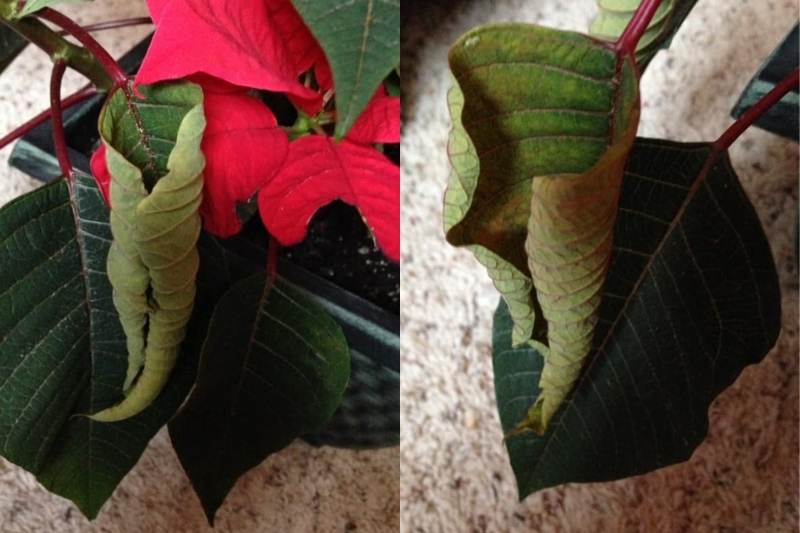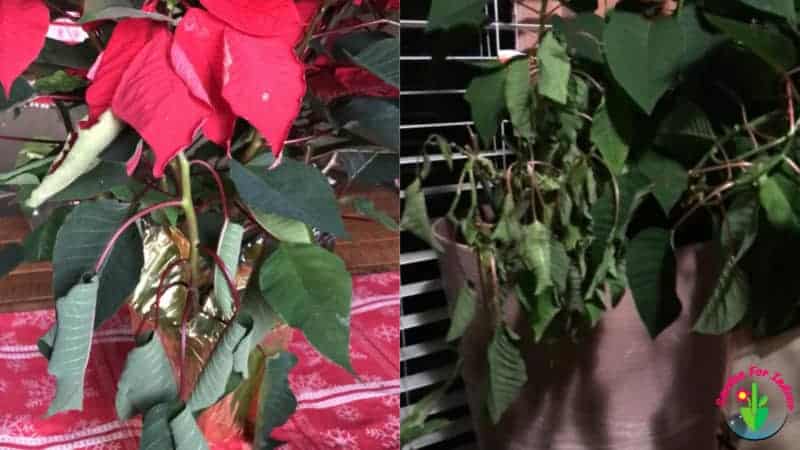Poinsettia leaves, which were so lovely when I first bought them, have begun to curl up at the edges. After that, the leaves wilt, curl and eventually fall off.
I did some research and found out that you need to keep your room warm (not too cold) and dry. I’ll fill you in on the specifics later, like what temperature you should maintain it at.
Since it’s commonly thought of as a winter flower, you might assume it thrives in chilly climates. And you may be wondering whether you should remove the curled leaves or leave them alone. But why do the leaves curl in the first place, and what can you do about it?
Contents
Why Do Poinsettia Leaves Curl And Wrinkle?

The main causes of poinsettia leaf curling or wrinkling are cold weather (warmer than 50-60 °F is necessary), lack of sunlight, lack of water, and root rot.
Poinsettia is well-known as a Christmas plant, so it might seem like it can survive in cold weather. However, the poinsettia is actually a tropical plant that comes from Mexico.
So, if you leave your poinsettia out in the cold, its leaves will curl because it doesn’t like the cold.
In temperatures below 50 degrees Fahrenheit (10 degrees Celsius), it begins to lose its leaves, and at 32 degrees Fahrenheit, it dies.
Our house gets below freezing in the winter, even inside, so I wondered if that was why, when growing poinsettias in a cold climate, you have to be a little more cautious.
It’s sad when a poinsettia, which means “good luck” in flower language, loses its vigor, so let’s protect it now!
Curling Poinsettia Leaves: Caused by Temperature or Dryness?
The poinsettia’s temperature of about 40 °F is just about enough to keep it from curling.
If you want your plants to flourish, you’ll need to keep them in a warm environment where the temperature stays at or above 60 degrees Fahrenheit.
In fact, it is easier to grow poinsettias in the summer than in the winter. Since it’s too cold for them to thrive outside during the winter, bringing them inside is best to keep them from curling.
Since it gets cooler at the door and near the window at night, it’s best to bring the poinsettia somewhere warmer during the day, like a table.
Poinsettias are sensitive to temperature changes, so even if the room is toasty warm during the day while you’re awake, it may be too cool for them at night.
Also, be careful if you want to keep your poinsettia warm by putting it near the air conditioner. Poinsettias are also sensitive to dryness or low humidity, so putting them in a place where the air conditioner blows directly on them is not a good idea.
Your poinsettia’s leaves may turn crispy in as little as a day if you leave it in a location where the cool air from an air conditioner blows directly on it.
Poinsettia Leaves Curl From Wrong Watering Practices
Next, the leaves may wilt and curl if the poinsettia doesn’t get enough water. They will wither and die if you do nothing more to help them, so go ahead and water them again.
Poinsettia leaves may also curl up if the plant has root rot from getting too much water.
The roots could rot if you leave the water in the saucer for more than a week. As the poinsettia’s roots rot, the lower leaves will turn yellow, and the leaves will curl, shrink and fall off.
At this point, giving fertilizer to a poinsettia in an effort to make the flower healthier is a bad idea because it will stress out the plant, ultimately leading to the poinsettia’s demise.
Use a misting spray rather than pouring water directly into the pot when watering poinsettias in the winter.
Not Enough Sunlight Can cause curling Poinsettia Leaves

Poinsettias should stay out of direct sunlight, but not getting enough sunlight can also make the leaves curl up. Specifically, the poinsettia’s lower leaves will begin to dry out and drop off.
Relocate your poinsettia to a spot where it can get at least some direct sunlight.
However, exposing a sick poinsettia to direct sunlight is not safe, so it is exposed for 2 to 3 hours per day and try to observe how it adapts.
(It gets cold at night by the window, so move the plant to a warmer spot.)
Overfeeding Poinsettia with Fertilizer
Excess salt and mineral formation occur when you apply too much fertilizer to your Poinsettia. It happens because water cannot drain all the fertilizer.
This condition will harm the beneficial microorganisms that naturally occur in the soil. Furthermore, it will result in soil pH alteration. This condition makes the nutrients less accessible to the plant.
Also, overfertilization can lead to the sudden growth of a plant with undeveloped roots. Such poor root structure might fail to supply adequate nutrients and moisture to the entire plant.
All these conditions stress the Poinsettia, leading to slow and stunted growth. Drooping, yellowing, and curling of the leaves will also occur.
What to Do When Poinsettia Leaves Curl Up Or Gets Wrinkled
If the leaves on your poinsettia are wrinkly or curled and no longer look healthy, you may not be able to enjoy it this holiday season because more leaves will probably fall off in the days to come.
However, if you take good care of the poinsettia, it may bloom again in the spring if the roots are still healthy.
Let’s take a look at
How can I tell if a poinsettia is going to live and do well?
Check the “stem color” of a poinsettia with curled leaves to find out.
- If the stalk is still green, there’s hope for recovery.
- Discolored and shriveled stems: perhaps it’s time to give up.
Changing the way you care for your poinsettia is necessary if its stem is still green, indicating that it is still alive.
Poinsettias struggle to thrive in environments that are too warm, too wet, too dry, or too extreme in any other way.
Here are some ideas for reviving poinsettias with curling leaves.:
- Keep the room with the poinsettia warm (at least 50 to 60 °F).
- Move it to a location where it will receive sunlight.
- Dry areas should be avoided (e.g., directly exposed to the wind from an air conditioner)
- Move it to a table top or another location if it gets cold at night ( entrance way or near a window will be cooler).
- If the soil is dry, water the leaves several times per day (mist with a sprayer and give water as a squirt).
- Do not use fertilizer from May to September.
- Do not water from May to September. Instead, mist the leaves with water.
- Place the poinsettia in a large clear plastic bag with the pot inside and place it somewhere warm.
- If any of the branches begin to turn brown, cut them down to the green portion.
- Don’t water if the roots look like they are rotting.
- Cut off any branches that are discolored.
If the poinsettia keeps expanding, you may need to move it to a larger container to ensure the roots have room to breathe.
Here are some issues outside of curling that you might encounter as a result of curling.
Why are my Poinsettia leaves falling off?
The primary culprit behind the falling of Poinsettia leaves is overwatering. An excessive amount of water leads to root rot.
If this happens, damaged roots will no longer effectively supply nutrients and moisture to the plant. Thus, the leaves will wilt and fall off.
Why are my Poinsettia leaves turning yellow?
There are a lot of possible reasons why your Poinsettia leaves turn yellow. But it is usually because of nutrient deficiency.
Ensure they receive sufficient light, water, and fertilizer to combat this shortage. Also, avoid keeping them in stressful conditions.
Read this article to know the causes and cures of poinsettia leaves turning yellow.
Can a Poinsettia survive without leaves?
A Poinsettia can survive without leaves with proper care if the stem is still green. Giving them what they need, such as adequate temperature, light, misting in the winter, and appropriate growing media, will help them thrive again.






